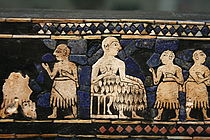Standard of Ur

"War" panel
|
|
| Material | shell, limestone, lapis lazuli, bitumen |
|---|---|
| Writing | cuneiform |
| Created | 2600 BC |
| Discovered | Royal Cemetery |
| Present location | British Museum, London |
| Identification | 121201 Reg number:1928,1010.3 |
 |
|
| Audio | |
|---|---|
|
|
|
| Video | |
|
|
The Standard of Ur comes from the ancient city of Ur (located in modern-day Iraq south of Baghdad). It dates to the Early Dynastic period and is c. 4,600 years old. The standard was probably constructed in the form of a hollow wooden box with scenes of war and peace represented on each side through elaborately inlaid mosaics. Although interpreted as a standard by its discoverer, its original purpose remains enigmatic. It was found in a royal tomb in Ur in the 1920s next to the skeleton of a ritually sacrificed man who may have been its bearer. It is now on display, in a reconstructed form, in the British Museum in London.
The artifact was found in one of the largest royal tombs in Ur, tomb PG 779, associated with Ur-Pabilsag, a king who died around 2550 BC. Sir Leonard Woolley's excavations in Mesopotamia in 1927–28 uncovered the artifact in the corner of a chamber, lying close to the shoulder of a man who may have held it on a pole. For this reason, Woolley interpreted it as a standard, giving the object its popular name, although subsequent investigation has failed to confirm this assumption. The discovery was quite unexpected, as the tomb in which it occurred had been thoroughly plundered by robbers in ancient times. As one corner of the last chamber was being cleared, a workman spotted a piece of shell inlay. Woolley later recalled that "the next minute the foreman's hand, carefully brushing away the earth, laid bare the corner of a mosaic in lapis lazuli and shell."
The Standard of Ur survived in only a fragmentary condition. The ravages of time over more than four thousand years caused the decay of the wooden frame and bitumen glue which had cemented the mosaics in place. The soil's weight crushed the object, fragmenting it and breaking its end panels. This made excavating the Standard a challenging task. Woolley's excavators were instructed to look for hollows in the ground created by decayed objects and to fill them with plaster or wax to record the shape of the objects that had once filled them, rather like the famous plaster casts of the victims of Pompeii. When the remains of the Standard were discovered by the excavators, they found that the mosaic pieces had kept their form in the soil, while their wooden frame had disintegrated. They carefully uncovered small sections measuring about 3 square centimetres (0.47 sq in) and covered them with wax, enabling the mosaics to be lifted while maintaining their original designs.
...
Wikipedia
